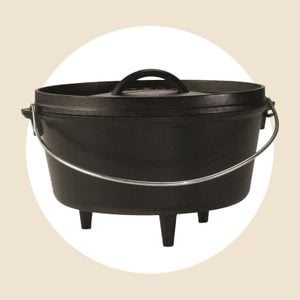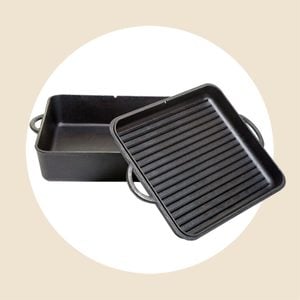How to Cook with a Dutch Oven When You’re Camping
Updated: Apr. 25, 2024
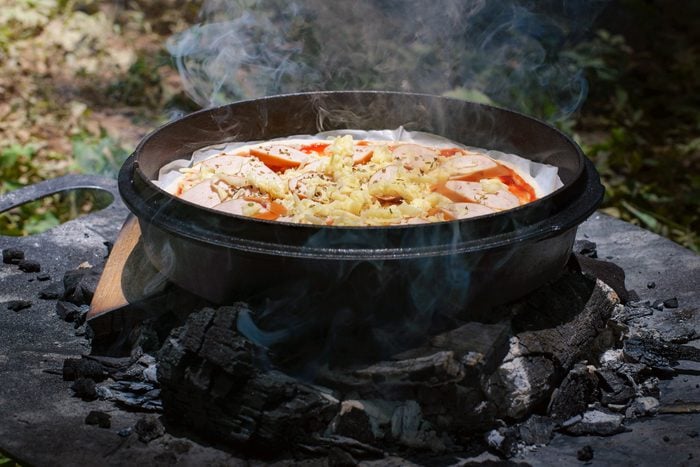
This in-depth guide to using a camping Dutch oven is for anyone ready to take open-fire cooking to the next level.
Our editors and experts handpick every product we feature. We may earn a commission from your purchases.
While there will always be a special place in our hearts for a blistered hot dog cooked over a campfire, there’s something to be said for the magic that happens when a meal is prepared with a camping Dutch oven.
From shepherd’s pie to Texas-style chili, soulful gumbo and even peach cobbler, a Dutch oven is an ultra-versatile piece of cooking equipment that needs to become a part of your essential camping packing list.
On This Page
What Is a Camping Dutch Oven?
Hold it! Don’t even think about sticking an enameled Dutch oven in a campfire. The Dutch ovens used at home are not the same as the ones made for the great outdoors.
The Difference Between Classic and Camping Dutch Ovens

Material and Finish
Home Dutch ovens (such as those made by Staub and Le Creuset) are made of cast iron and sealed in enamel. This enamel, which is beautiful and makes for easier cleaning, can become damaged when exposed to the high direct heat of an open campfire.
Camping Dutch ovens are also made of cast iron. However, they’re typically uncoated and rely on seasoning to create a nonstick cooking surface. These pieces of cookware are seasoned the same way you season a cast-iron skillet.
Support Legs
Unlike home Dutch ovens, which have a flat bottom, many camping Dutch ovens are made with short support legs that provide stability in a campfire and allow hot coals to be tucked underneath.
Lid Design
It’s not uncommon for home Dutch ovens to have a slightly domed lid. This shape helps circulate the heat and trap steam inside for even cooking.
A camping Dutch oven, on the other hand, needs to have a completely flat lid with a shallow, raised rim around the edge. This shape allows for hot coals to be placed on top without rolling off while cooking.
Handle
Home Dutch ovens typically have a short knob for a handle that looks nice but is not ideal for campfire cooking.
Camping Dutch ovens most often have a large, pail-style handle that can easily pivot so the pot can be picked up and moved around the fire. Its design also allows for the Dutch oven to be hung from a campfire tripod.
Ways to Use Your Campfire Dutch Oven
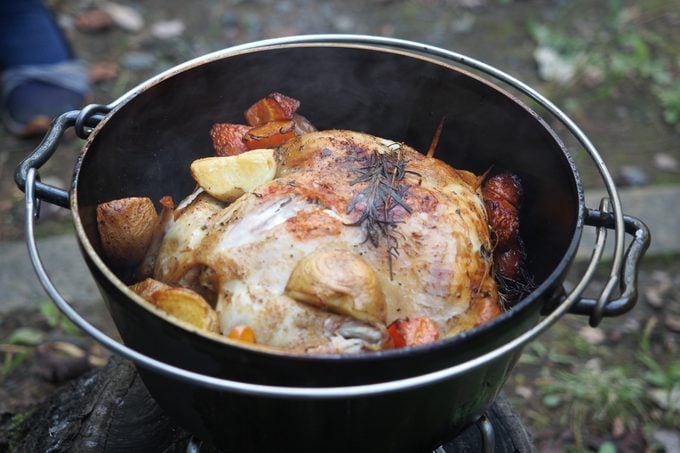
Now that you know what makes a camping Dutch oven unique, let’s talk about how to use one over the open flames of a campfire.
The beauty of a Dutch oven is that it opens a door to all kinds of cooking methods when camping.
- Simmer and boil: Use your Dutch oven as a heavy-bottomed pot to cook a batch of your favorite soup, stew or chili recipe. You can even boil pasta and enjoy a hearty Italian dinner al fresco in your hammock.
- Sear: Made of cast iron, which is great for high-heat cooking because it transfers heat evenly, a Dutch oven can be used like a skillet for searing steaks, chops and chicken.
- Steam: With a tight-fitting lid, a Dutch oven is ideal for steaming rice, vegetables or even lobster tails. All you need is a bit of water and a basic steaming basket that fits inside.
- Saute and pan fry: Make a stir-fry, saute onions or, for fisherman, fry up your fresh catch of the day in a bit of cooking oil.
- Braise: For slow days around the campsite, use a Dutch oven for some low and slow braising. Braising in a Dutch oven requires dual-direction heating, meaning coals will need to be placed on the top and below the Dutch oven to create a moist, even cooking environment for braised short ribs, chicken thighs or pot roast.
- Bake: You can bake in a Dutch oven by placing coals on top and below the vessel to create an oven-like environment. From artisanal no-knead bread to coffee cake, cinnamon rolls, apple pie, biscuits and more—if you can dream it you can (probably) bake it in a Dutch oven.
Heating Methods
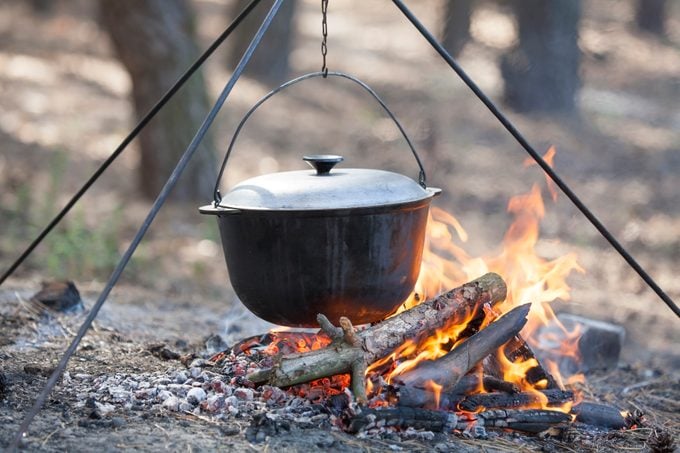
The way you heat your Dutch oven will depend on your desired cooking method.
As mentioned above, baking and braising will require dual-direction heating, meaning you will need to place hot coals below and on top of the Dutch oven to create the proper cooking environment.
All other methods require a singular heat source from below. You can place your Dutch oven directly over hot coals or wood embers in your campfire set your Dutch oven on a campfire cooking grate (found on some campfire rings) or opt to hang your Dutch oven from a campfire tripod.
Editor’s Tip: Depending on your camp stove, you may also be able to place your camping Dutch oven on one of the burners, if the Dutch oven’s support legs can fit between the burner grates.
Dutch Oven Temperature Guide
Getting the temperature just right in your Dutch oven is perhaps the biggest learning curve of campfire cooking (especially after you’ve masted these other camping cooking tips).
Most campfire Dutch oven recipes (especially those for baking) require a temp of 350°F. Without an oven thermometer, it can be difficult to gauge when your Dutch oven reaches this temperature.
Luckily, there’s a simple formula you can use to determine how many charcoal briquettes or wood embers you’ll need to get close to this temperature sweet spot. Simply double the diameter of your Dutch oven and add 1. So, an 8″ Dutch oven will need 17 briquettes for 350°F.
When baking or braising you’ll want to puta third of the briquettes below the Dutch oven and the remaining briquettes on the lid of the Dutch oven.
This handy chart will help you get it right! (Having trouble? Here’s a guide to common Dutch oven mistakes.)
Dutch Oven Temperature Chart
|
8″ oven |
10″ oven |
12″ oven |
14″ oven |
|
|
325°F |
15 (10 Top / 5 Under) |
19 (13 Top / 6 Under) |
23 (16 Top / 7 Under) |
30 (20 Top / 10 Under) |
|
350°F |
16 (11 Top / 5 Under) |
21 (14 Top / 7 Under) |
25 (17 Top / 8 Under) |
32 (21 Top / 11 Under) |
|
375°F |
17 (11 Top / 6 Under) |
23 (16 Top / 7 Under) |
27 (18 Top / 9 Under) |
34 (22 Top / 12 Under) |
|
400°F |
18 (12 Top / 6 Under) |
25 (17 Top / 8 Under) |
29 (19 Top / 10 Under) |
36 (24 Top / 12 Under) |
|
425°F |
19 (13 Top / 6 Under) |
27 (18 Top / 9 Under) |
31 (21 Top / 10 Under) |
38 (25 Top / 13 Under) |
|
450°F |
20 (14 Top / 6 Under) |
29 (19 Top / 10 Under) |
33 (22 Top / 11 Under) |
40 (26 Top / 14 Under) |
This method is not always exact but a good starting point for most recipes. The amount of food you’re cooking, outside air temperature and heat source (briquettes vs wood embers) will all ultimately affect cooking temperature.
Editor’s Tip: For best results, we recommend packing an instant-read thermometer so you can gauge the internal temperature of any meat or poultry you’re preparing. Safety first!
What to Cook in a Dutch Oven
Are you hungry yet? Our favorite thing about camping Dutch ovens is that it allows you to use a single piece of cooking equipment for breakfast, lunch and dinner (plus dessert). Here are some of our camping Dutch oven recipes for every meal of the day.
Dutch Oven Breakfast Recipes
Dutch Oven Lunch & Dinner Recipes
Dutch Oven Dessert Recipes
The Best Outdoor Dutch Ovens
Don’t own a camping Dutch oven? If you’re looking to invest in one of these amazing and versatile pieces of outdoor cookware, here are a few of our favorites for the rugged outdoorsperson in you:
- Lodge cast-iron deep camp Dutch oven: Lodge makes one of our Test Kitchen’s favorite cast-iron skillets. They also make a versatile camping Dutch oven outfitted with legs and a sturdy handle.
- Barebones cast-iron Dutch oven: This American-made Dutch oven is designed to be used in the outdoors. Its unique lid allows you to seal the pot tight or twist to vent as you cook.
- Camp Chef square Dutch oven: While round and oblong Dutch ovens are the most common, you may find that a square option fits your needs. This square Dutch oven is great for campfire casseroles. You can also use the lid as a grill pan.
After adding one of these top camping Dutch ovens to your shopping cart, take a look at our favorite Dutch oven accessories.
Outdoor Dutch Oven Cleaning and Seasoning
Be good to your Dutch oven and it will be good to you. For these rustic pieces of cookware, you’ll treat them more like a cast-iron skillet than a classic enamel-coated Dutch oven. This means you’ll follow these cast-iron pan care and cleaning tips. Start by wiping away any excess food bits and then washing the kettle clean.
Ideally, your Dutch oven will build up a nice seasoning naturally over time as you use it. However, if yours needs a bit of TLC, here’s an in-depth guide detailing how to season a cast-iron Dutch oven.












